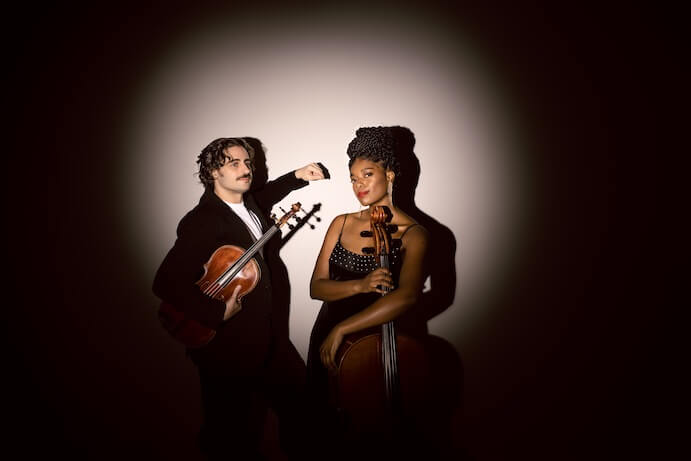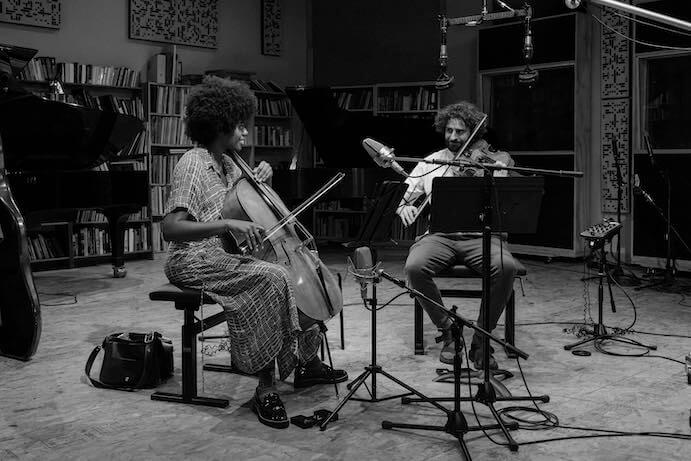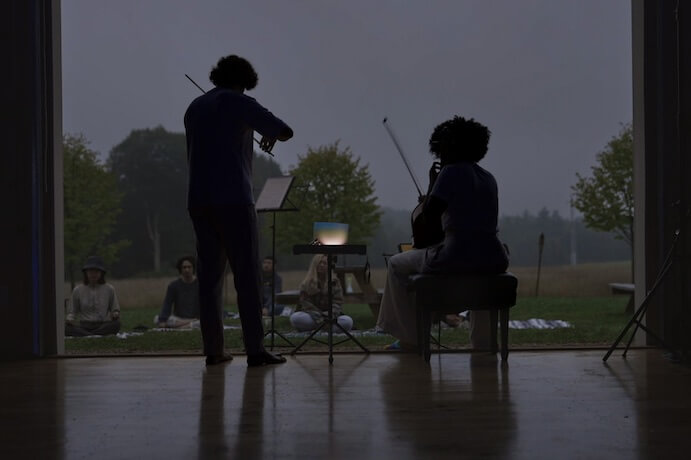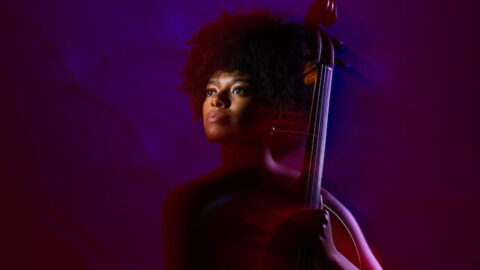Titilayo Ayangade started playing cello at age five, but her passion didn’t ignite until she discovered chamber music in her teens. She loved the intimate art of conversing with friends using instruments instead of words, and she wanted to hone her skills so that more people would want to play with her. The hard work paid off: Ayangade earned music degrees from University of Cincinnati-CCM and the University of Texas at Austin; has toured all over the world, became a Strathmore Artist-in-Residence; and served a five-year tenure as cellist of the acclaimed Thalea String Quartet, with whom she won top prizes at the Fischoff and Chamber Music Yellow Spring international competitions.
These days, Ayangade is channeling her passion for chamber music into duo kayo, which she formed with her fiancé, violist Edwin Kaplan (of the Tesla Quartet). Cello and viola make for an unusual combo, but Ayangade delights in the darker string tones; the duo, known for their “joyous musical expression,” likes to challenge traditional norms anyway. Take their latest project, for example, funded by a Sphinx Artist MPower Grant: a recording of their newly-commissioned work by Curtis Stewart, inspired by the music of Gil Scott Heron’s “The Revolution Will Not Be Televised.”
Photography is a comparatively later addition to Ayangade’s artistic portfolio, but she’s already found tremendous success with it. To date, she has photographed hundreds of musicians (clients include the Colburn School, New York Youth Symphony, and members of the San Francisco Symphony), and in 2023, Ayangade was selected to attend the prestigious Eddie Adams Workshop for emerging photographers. On the workshop’s podcast, “The Long Roll”, Ayangade explained how her sense of music informs the way she shoots: “Music emits sound, and photos emit light,” she said. [When I’m photographing subjects], I try to show what kind of inner light a person has, or in some way, to show what they sound like.”
Ayangade’s artistic energy is infectious, and I was eager to ask her more about her photography, rehearsal process, and inspirations.

As a former member of the Thalea String Quartet and now one half of duo kayo, you’ve gotten to channel your chamber music energy into two very different kinds of groups. What are the differences and similarities between working in your duo versus the quartet?
The transition from performing in the Thalea String Quartet to duo kayo and beyond has given me a bone-deep understanding of how varied chamber ensembles work; how the communication unfolds and how the artistic product takes shape.
Working in the quartet, the combinations of the four personalities and musical identities were in constant flux, therefore the dynamic was always changing. This required a very complex ecosystem in which decision-making was done by committee, with lots of negotiation and compromise. In a quartet, each person brings their voice to a shared vision, and the struggle lies in balancing all these different points of view without sacrificing the strength of that vision.
Unlike the quartet, duo kayo feels much more intimate and personal, like an extension of a conversation between two close friends. Everything in the duo centers around that relationship between me and my musical partner, Edwin. There’s directness in how we communicate– with only two instruments, there’s room for each of us to harness our voice, but we have to be inside each other’s pocket at the same time. It’s another kind of challenge, but it takes deep trust and understanding. The immediacy and spontaneity of these interactions allow us to take greater risks and go deeper in new ideas right on the spot with less deliberation.

Speaking of which, your duo seems to be flourishing in multiple directions at once — it’s quite impressive! In addition to performances and residencies, you just finished recording your Gil Scott Heron-inspired commission and recently launched Daybreak, a sunrise/early morning meditation and concert series. What fires you up about these projects?
We had a really great summer! It was a great blessing to be able to return to both Caramoor and Newport Classical. Last summer, Edwin and I were the Festival Artists at Newport, which was a fun experience playing together in a quartet/quintet formation. We premiered a work by Curtis Stewart entitled The Gilded Cage, which was what really spurred us to consider commissioning him. We just loved his language and writing. His new work for us, titled Threat, explores the way ephemeral things, like history and culture, become erased with time.
We made Curtis a hodgepodge of a playlist when we were first dreaming up what the piece could be. He did a really masterful job of melding all of the inspiration and his signature style together. Threat calls for the performer to shout, stomp, sing and otherwise vocalize; declamatory actions not often found on your typical classical stage. We had the great pleasure of premiering it this past July at Newport Classical in a gallery full of Black art by the famed Jamaican American photographer Renee Cox.
We saw the commissioning project, which was funded by Chamber Music America and Sphinx, as a chance to flip tradition on its head and borrow influences from other genres that fit within our personal artistic vision, such as hip hop, spoken word, and soul. This project is significant to me because it was an idea stemming from shared heritage and community conversations about the ongoing gentrification and identity of Harlem. Scott-Heron was adept at melding music and social commentary, often using his art as a call to action against injustices and inequalities. We wanted to pay homage to that legacy while also finding ownership in a new message: the so-called “threat” is ongoing.
Daybreak is a new brainchild of ours that grew out of the idea that music deserves to be made anytime and anywhere. Typically hosted just after daybreak, up until noon, we are offering a safe space to ease into the day. The series explores how music can have a calming influence on our different states of mind and our daily life. The combination of pre-composed music alongside improvisation and meditation creates a space where people can disconnect from the stresses of everyday life and reconnect with themselves before embarking on their usual day-to-day. The events are about reaching beyond the music and creating moments of reflection, healing, and connection.

As a cellist, you’ve long nurtured your classical chops while developing a unique style and actively seeking new repertoire. How do you prime yourself – via practice, media consumption, or other habits – to operate on the musical level that you do?
I’ve been playing cello for a whole lifetime – 27 years to be exact. The answer to this question has morphed over the years, but most important to me is to keep consistent daily contact with my instrument. On any given day I might have a recording session, orchestra rehearsal with different ensembles, composer reading, photoshoot, chamber music coaching, duo rehearsal, a performance, etc.
This means that I have to maintain my flexibility, which I do by creating little ear training exercises as warm-ups. It’s become great fun to cue up a song and improvise to it, which is the perfect challenge for my ears and fingers. It also gets me out of my head and into the present – a “one-shot” mentality can be useful when you only have a handful of times to sit with the music before you have to deliver your very best.
Over time, I’ve learned to give myself grace and remember that I’m here to connect with my cello, not dominate it. But of course, apart from the mental work, I find it imperative to take in a lot of different types of culture. I love reading all kinds of literature, and I’m currently recommending the book Rest is Resistance by Tricia Hersey to everyone. I find it to be particularly regenerative to allow myself the time to simply sit and think. At this point in my life and career, I find myself on an introspective journey of unlearning and rediscovering what my authentic musical voice actually is, which requires patience. I also love attending my fellow musicians’ concerts, where I am frequently delighted and inspired by their own journeys to the stage.
How has developing your craft as a photographer impacted your musicianship?
While photography and music are most likely viewed as two completely different disciplines, I have found that they strongly and surprisingly complement each other. Both pursuits are ways of telling a story that require attention to detail and the curiosity to wonder what might come next. This anticipation has taught me to have patience for what can only be observed, not controlled. Photographers refer to it as the “decisive moment” – a term coined by photographer Henri Cartier-Bresson to represent the synchronous alignment of events. This liminal space exists while performing as well, and can only be observed while being as present as possible.
Just like in photography, it not only matters what one presents in music, but how one presents it. Even the most profound piece of music will echo with emptiness in a dimly lit hall without the repartee of a sympathetic live audience. Just as a slight shift in attack or attitude can completely transform the experience of a piece of music, an adjustment in angle or hue saturation can transform the meaning of an image. Photography has helped me to become more aware of these nuances in my playing: more thoughtful about how I want to “frame” each moment in a performance, and how to draw the audience’s attention to what matters most.

You’re currently working on a project honoring and celebrating BIPOC musicians through photography. What was the inspiration for that, and how is it going so far?
This project is deeply personal for me and co-exists alongside my other commissioned photo work. As a Black woman in classical music, I’ve often felt othered or like a lost voice in a space that historically hasn’t been very inclusive. Throughout my career, I’ve encountered many incredible BIPOC musicians — artists who are not only brilliant in their craft, but also personally invested in existing as themselves in this realm that remains largely homogeneous. Their stories are not always told, their contributions not always recognized. This project is my way of changing that on my own terms.
The inspiration for this project stems from my own experiences with self portraiture beginning 10 years ago. It also comes from the rampant tokenism where revered institutions, having less than a 25% BIPOC demographic (2.4% Black to be precise), place us on the front page; a virtue signal of diversity. Many of the conversations I’ve had with fellow musicians center around the idea of poor self image or a fear of being perceived as too much. Nonetheless, there’s a shared understanding in the community that our stories are important, that our contributions to classical music deserve to be celebrated and documented.
This dichotomy is a call to action. As my other creative outlet, equal to cello, photography felt like the natural medium to express my care for this community because it’s such a powerful tool for visibility. Looking to the near future, I’m thinking about incorporating short musical vignettes to give my colleagues a platform to share their stories in their own vernacular. I’m in the process of applying for grant funding to be able to showcase this as an art exhibit. Ultimately, I want this project to be as multifaceted as the musicians it celebrates. We are not a monolith.
I CARE IF YOU LISTEN is an editorially-independent program of the American Composers Forum, and is made possible thanks to generous donor and institutional support. Opinions expressed are solely those of the author and may not represent the views of ICIYL or ACF.
You can support the work of ICIYL with a tax-deductible gift to ACF. For more on ACF, visit composersforum.org.
























